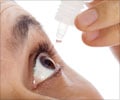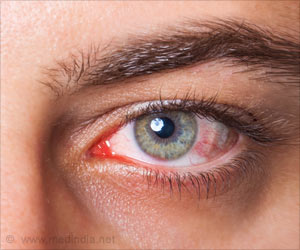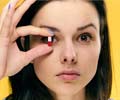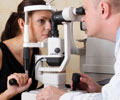Blinking spreads tears evenly, reduces evaporation, and stimulates tear production, keeping eyes moist and healthy.
- Blinking spreads a fresh layer of tears across the eye, preventing dryness
- Frequent blinking reduces tear evaporation caused by prolonged screen use
- Regular blinking stimulates tear-producing glands, ensuring adequate lubrication
Dry Eye Syndrome
Go to source). Let's explore how blinking can prevent dry eye syndrome, the science behind it, and tips to incorporate more blinking into your daily routine.
The average person blinks about 15-20 times per minute, but when focused on screens, this rate can drop to just 5-7 times per minute, increasing the risk of dry eye syndrome! #eyehealth #dryeyes #blinkmore #medindia’
What is Dry Eye Syndrome?
Dry eye syndrome, also known as dry eye disease or keratoconjunctivitis sicca, is a condition where the surface of the eye lacks adequate lubrication. This can result from:Insufficient tear production:
The eyes do not produce enough tears to keep the surface moist.Excessive tear evaporation:
Tears evaporate too quickly due to environmental factors or eyelid issues.Imbalance in tear composition:
Tears consist of three layers (oil, water, and mucus). An imbalance in these layers can cause instability and quick evaporation.What are the Symptoms of Dry Eye Syndrome?
Symptoms of dry eye syndrome include:- Itchy, scratchy, or burning sensation in the eyes
- Redness
- Blurred vision
- Sensitivity to light
- Feeling of something in the eye
Role of Blinking
Blinking is an automatic and vital function of the eyes. On average, a person blinks around 15-20 times per minute (2✔ ✔Trusted SourceReal-Time Blink Detection as an Indicator of Computer Vision Syndrome in Real-Life Settings: An Exploratory Study
Go to source). This simple action plays a crucial role in maintaining eye health by:
Spreading Tears Evenly:
Each blink spreads a fresh layer of tears across the surface of the eye, keeping it moist and comfortable.Removing Debris:
Blinking helps clear away small particles and debris that may accumulate on the surface of the eye, protecting it from irritation and potential infections.Nourishing the Cornea:
The tears contain nutrients and oxygen essential for the health of the cornea (the clear, dome-shaped surface that covers the front of the eye).How Blinking Prevents Dry Eye Syndrome
Blinking is a natural and essential function that plays a crucial role in maintaining eye health and preventing dry eye syndrome. By understanding the importance of blinking and incorporating regular blinking habits into your daily routine, you can keep your eyes comfortable, moist, and healthy (3✔ ✔Trusted SourceTherapeutic benefits of blinking exercises in dry eye disease
Go to source).
Maintaining Tear Film Stability
The tear film is a thin layer that covers the surface of the eye, consisting of three layers: lipid (oil), aqueous (water), and mucin (mucus). Each layer plays a vital role in maintaining eye moisture and health:
- Lipid Layer: Prevents evaporation of the aqueous layer.
- Aqueous Layer: Provides moisture and supplies oxygen and nutrients.
- Mucin Layer: Helps spread the aqueous layer evenly over the eye surface.
Reducing Tear Evaporation
Infrequent blinking, often caused by prolonged screen use or intense concentration, can lead to increased tear evaporation. When we stare at screens, we tend to blink less frequently, causing the tears to evaporate more quickly. Regular blinking helps to reduce tear evaporation by keeping the eyes moist and refreshed.
Stimulating Tear Production
Blinking stimulates the glands in the eyelids that produce the components of the tear film. By blinking regularly, we encourage these glands to function properly, ensuring a consistent supply of tears to keep the eyes lubricated.
Tips to Encourage Regular Blinking
Modern lifestyles, especially those involving prolonged screen time, can disrupt natural blinking patterns. Here are some tips to help you blink more regularly and prevent dry eye syndrome:Follow the 20-20-20 Rule
To reduce eye strain and encourage regular blinking, follow the 20-20-20 rule. Every 20 minutes, take a 20-second break and look at something 20 feet away. This not only gives your eyes a break from screens but also prompts you to blink more frequently (4✔ ✔Trusted Source
Digital eye strain: prevalence, measurement and amelioration
Go to source).
Practice Conscious Blinking
Make a conscious effort to blink more often, especially when using digital devices. Set reminders on your phone or computer to take regular blinking breaks.
Adjust Your Screen Settings
Ensure your screen is at a comfortable height and distance to avoid straining your eyes. Lower the brightness and adjust the contrast to reduce glare, making it easier for your eyes to stay comfortable.
Stay Hydrated
Proper hydration is essential for overall eye health. Drink plenty of water throughout the day to keep your body, including your eyes, well-hydrated.
Use Artificial Tears
If you suffer from dry eye syndrome, over-the-counter artificial tears can help supplement your natural tear production. Use them as directed to keep your eyes moist and comfortable.
Blink Exercises
Performing blink exercises can help improve your blinking habits. Try this simple exercise: close your eyes normally, pause for two seconds, squeeze your eyelids together gently, and then open them. Repeat this 5-10 times to stimulate tear production and improve tear film stability.
While regular blinking can help prevent dry eye syndrome, it is essential to consult an eye care professional if you experience persistent symptoms. An optometrist or ophthalmologist can provide a comprehensive eye exam and recommend appropriate treatments, such as prescription eye drops, medications, or lifestyle changes. Your eyes are invaluable, and taking simple steps to care for them can make a significant difference in your overall well-being.
References:
- Dry Eye Syndrome - (https://pubmed.ncbi.nlm.nih.gov/29262012/)
- Real-Time Blink Detection as an Indicator of Computer Vision Syndrome in Real-Life Settings: An Exploratory Study - (https://pubmed.ncbi.nlm.nih.gov/36901579/)
- Therapeutic benefits of blinking exercises in dry eye disease - (https://pubmed.ncbi.nlm.nih.gov/32409236/)
- Digital eye strain: prevalence, measurement and amelioration - (https://pubmed.ncbi.nlm.nih.gov/29963645/)
Source-Medindia
















